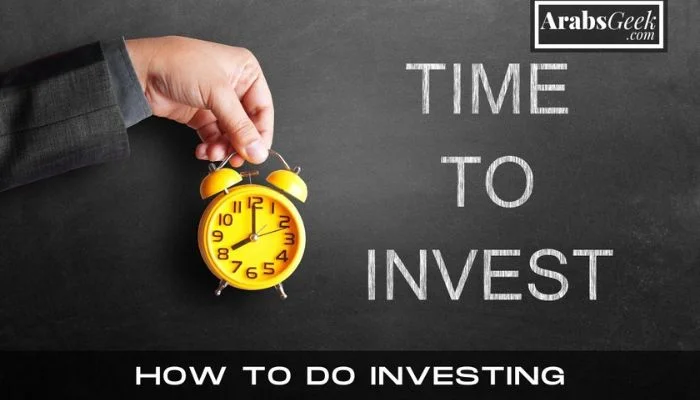Introduction | How To Do Investing
You’ve probably heard the phrase “make your money work for you.” Well, investing is one of the best ways to do that. But if you’re new to investing, the whole process can seem daunting and complicated. Don’t worry, this guide will walk you through the basics of investing, the process, the various investment options, and tips for success. So, are you ready to make your financial dreams come true? Let’s get started!
Table of Contents
Understanding Investing
What is investing? | How To Do Investing
Investing involves putting your money into assets such as stocks, bonds, mutual funds, real estate, or even a startup business, with the expectation that you will make a profit over time. The main goal of investing is to grow your wealth and potentially generate income.
For any business enquiry, you can contact us at ArabsGeek.com
For more of such financial articles, Consider visiting our sister website at EntrepreneursPilot.com
Why is investing important?
Investing is crucial for several reasons. It provides a way to grow your money and outpace inflation, protecting your purchasing power in the future. Moreover, investing can help you reach financial goals, such as buying a house, paying for a child’s education, or building a retirement nest egg.
The Basics of Investing
Types of investments | How To Do Investing
There are many types of investments, or “asset classes,” including stocks, bonds, mutual funds, exchange-traded funds (ETFs), and real estate. Each asset class has its own level of risk and potential return. A well-rounded investment portfolio often includes a mix of these asset classes.
Risk and return
Investing involves a certain level of risk. Generally, the higher the potential return, the higher the risk. It’s important to understand your own risk tolerance when investing. Balancing risk and return is a key aspect of successful investing.
Diversification
Diversification is a strategy that involves spreading your investments across various asset classes to reduce risk. The idea is that if one investment performs poorly, others may perform well, offsetting the loss.
The Process of Investing | How To Do Investing
Establish your financial goals
Before you start investing, it’s important to determine your financial goals. Are you saving for a down payment on a house? Planning for retirement? Understanding your goals will help guide your investment decisions.
Determine your risk tolerance
Your risk tolerance refers to your ability to withstand losses in your investments. This can depend on your financial situation, your investment horizon, and your personal comfort with risk. Determining your risk tolerance will help you choose investments that are right for you.
Choose your investment strategy
Your investment strategy will depend on your financial goals and risk tolerance. You can choose to be a conservative investor, a moderate investor, or an aggressive investor. Conservative investors prefer lower-risk investments, while aggressive investors are willing to take on more risk for the chance of higher returns.
Investment Options
Stocks | How To Do Investing
When you buy a stock, you are buying a piece of a company. Stocks have the potential for high returns, but they also carry a high level of risk. It’s important to research and understand the company before investing in its stock.
Bonds
Bonds are essentially loans that you give to a company or government entity. The issuer promises to pay you back the loan amount, plus interest, at a specified date. Bonds are generally considered lower-risk than stocks.
Mutual Funds and ETFs
Mutual funds and ETFs are investment vehicles that pool money from many investors to invest in a diversified portfolio of stocks, bonds, or other assets. These can be a good option for beginners as they offer instant diversification.
Making an Investment Plan
Develop an investment policy statement
An investment policy statement (IPS) outlines your investment goals, risk tolerance, time horizon, and investment strategy. It serves as a guide for your investment decisions and can help you stay on track, even when the market gets shaky.
Select your investments | How To Do Investing
Based on your IPS, select the investments that align with your strategy. This might include a mix of stocks, bonds, mutual funds, or ETFs. It’s important to diversify your portfolio to spread out risk.
Monitor and adjust your portfolio
Investing is not a set-it-and-forget-it activity. It’s important to regularly monitor your portfolio and make adjustments as needed. This can help ensure your investments continue to align with your goals and risk tolerance.
Tips for Successful Investing
Invest for the long term | How To Do Investing
It’s important to have a long-term perspective when investing. Although the market can be volatile in the short term, it has historically trended upward over the long term. Staying invested, even during downturns, can be beneficial.
Don’t try to time the market
It’s nearly impossible to consistently predict market highs and lows. Instead of trying to time the market, consider a strategy known as dollar-cost averaging, where you invest a fixed amount at regular intervals, regardless of the market conditions.
Stay informed | How To Do Investing
The investment world is always changing, so it’s important to stay informed. Regularly review your investments, stay current on financial news, and consider seeking advice from a financial advisor.
Don’t let emotions control your decisions
Investing can be an emotional roller coaster. But making decisions based on fear or greed can lead to poor outcomes. Stick to your investment plan and avoid making impulsive decisions.
Conclusion | How To Do Investing
Investing can be a powerful tool for building wealth and achieving your financial goals. By understanding the basics, choosing the right investment options for your needs, and following sound investment practices, you can navigate the world of investing with confidence.
Frequently Asked Questions (FAQs)
Q1. How much money do I need to start investing?
You don’t necessarily need a lot of money to start investing. Many mutual funds and online brokerage firms have low minimum investment requirements. Even investing a small amount can add up over time thanks to compound interest.
Q2. Should I pay off debt or invest?
This depends on your individual circumstances, including the interest rate on your debt and your potential investment returns. In general, if the interest rate on your debt is higher than what you can reasonably expect to earn by investing, it might be better to pay off the debt first.
Q3. What is the difference between stocks and bonds?
When you buy a stock, you’re buying a piece of a company and can potentially benefit if the company does well. When you buy a bond, you’re essentially lending money to a company or government entity in exchange for periodic interest payments and the return of the loan amount at maturity.
Q4. Can I lose all my money in investing?
While there’s always a risk of loss when investing, it’s unlikely you’d lose all your money if you’re diversified across different types of investments and asset classes.
Q5. How often should I check my investments?
While it’s important to monitor your investments, checking them too frequently can lead to stress and impulsive decisions. Consider reviewing your portfolio every few months or at least annually.











